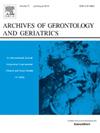中国老年人内在能力与 2 型糖尿病发病率的关系广州生物库队列研究
IF 3.5
3区 医学
Q2 GERIATRICS & GERONTOLOGY
引用次数: 0
摘要
背景世界卫生组织将内在能力(IC)作为衡量健康老龄化的标准。然而,我们没有发现关于内容量与 2 型糖尿病(T2DM)之间关系的报告。我们调查了广州生物库队列研究中老年中国人的内在能力与 T2DM 发病之间的关系。IC 综合得分(0-10 分)分为三组:差(0-5.9 分)、一般(6.0-8.9 分)和高(9.0-10 分),得分越高代表 IC 越高。结果 在平均年龄为 59.1 岁(标准差(SD)=7.13)、无糖尿病基线的 3582 名参与者中,在平均 3.3 年(SD=0.86)的随访期间,497 人(13.87%)患上了 T2DM。在对潜在的混杂因素进行调整后,基线 IC 较差与较高者相比,随访时空腹血糖、负荷后 2 小时血糖和糖化血红蛋白 A1c 均较高,发生 T2DM 的风险也较高(HR (95%CI):1.80 (1.20, 2.72))。结论我们首次报告了IC和活力低下与血糖升高和T2DM发病风险的前瞻性关联。增强肌肉力量以提高功能能力可能是降低老年人群未来 T2DM 风险的一种干预措施。本文章由计算机程序翻译,如有差异,请以英文原文为准。
Association of intrinsic capacity with incident type 2 diabetes mellitus in older Chinese: Guangzhou Biobank Cohort Study
Background
The World Health Organization introduced intrinsic capacity (IC) as a metric for healthy aging. However, we found no report on the association between IC and type 2 diabetes mellitus (T2DM). We investigated the association between IC and incident T2DM in older Chinese from the Guangzhou Biobank Cohort Study.
Methods
IC was assessed across five domains equally: locomotion, vitality, cognition, psychological and sensory. Composite IC scores (0–10) were classified into three groups: poor (0–5.9), fair (6.0–8.9), and high (9.0–10), with higher scores representing greater IC. Multivariable linear regression and cox regression was used to analyze the association between IC with glycemia and T2DM, respectively.
Results
Of 3582 participants with a mean age of 59.1 years (standard deviation (SD)=7.13) without baseline diabetes, during an average follow-up of 3.3 years (SD=0.86), 497 (13.87%) developed T2DM. After adjustments for potential confounders, those with baseline poor IC, versus high, had higher fasting glucose, 2-hour post-load glucose and glycosylated hemoglobin A1c at follow-up, and a higher risk of incident T2DM (HR (95%CI): 1.80 (1.20, 2.72)). Among IC domains, only vitality impairment was associated with an increased risk of T2DM (P for trend < 0.001).
Conclusion
We first reported the prospective associations of poor IC and vitality with higher glycemia and incident T2DM risk. Enhancing muscle strength to improve functional ability may be a possible intervention for reducing future risk of T2DM in older populations.
求助全文
通过发布文献求助,成功后即可免费获取论文全文。
去求助
来源期刊
CiteScore
7.30
自引率
5.00%
发文量
198
审稿时长
16 days
期刊介绍:
Archives of Gerontology and Geriatrics provides a medium for the publication of papers from the fields of experimental gerontology and clinical and social geriatrics. The principal aim of the journal is to facilitate the exchange of information between specialists in these three fields of gerontological research. Experimental papers dealing with the basic mechanisms of aging at molecular, cellular, tissue or organ levels will be published.
Clinical papers will be accepted if they provide sufficiently new information or are of fundamental importance for the knowledge of human aging. Purely descriptive clinical papers will be accepted only if the results permit further interpretation. Papers dealing with anti-aging pharmacological preparations in humans are welcome. Papers on the social aspects of geriatrics will be accepted if they are of general interest regarding the epidemiology of aging and the efficiency and working methods of the social organizations for the health care of the elderly.

 求助内容:
求助内容: 应助结果提醒方式:
应助结果提醒方式:


